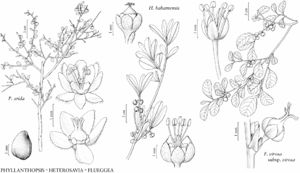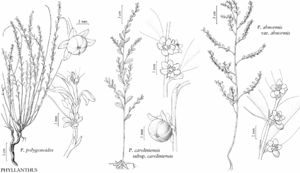Phyllanthaceae
Herbs, shrubs, or trees, perennial or annual, deciduous or evergreen, monoecious or dioecious. Leaves alternate [rarely opposite], simple (pinnately compound in Bischofia); stipules present [rarely absent]; petiole usually present, sometimes absent; blade margins entire or crenate-serrate; venation pinnate. Inflorescences unisexual or bisexual, axillary [rarely supra-axillary or terminal], racemelike or paniclelike [spikelike] thyrses, cymes, fascicles, or glomes, or flowers solitary. Flowers unisexual; perianth hypogynous; hypanthium absent; sepals 4–6, distinct or connate basally to most of length; petals 0 or [4–] 5 [–6], distinct; nectary present or absent; stamens 2–5 [–50], distinct or connate, free; anthers dehiscing by longitudinal slits; pistil 1, [2–] 3–10 [–15] -carpellate, ovary superior, [2–] 3–10 [–15] -locular, placentation axile; ovules 2 per locule, anatropous or hemitropous; styles [2–] 3–10 [–15], distinct or connate, unbranched or 2-fid; stigmas [2–] 3–10 [–15] (as many as style divisions). Fruits usually capsules, dehiscence septicidal, (usually schizocarpic with cocci separating from persistent columella, coccus usually dehiscent loculicidally), sometimes berries or drupes. Seeds 1–2 per locule.
Distribution
North America, Mexico, West Indies, Central America, South America, Eurasia, Africa, Indian Ocean Islands, Pacific Islands, Australia, in Bermuda, Atlantic Islands (Macaronesia), primarily tropical and warm temperate regions
Discussion
Genera ca. 60, species ca. 2000 (7 genera, 23 species in the flora).
The genera that make up Phyllanthaceae traditionally have been treated as Euphorbiaceae subfam. Phyllanthoideae Beilschmied. Molecular data (Angiosperm Phylogeny Group 2003; K. Wurdack et al. 2004; C. C. Davis et al. 2005; Wurdack and Davis 2009; Z. Xi et al. 2012) strongly support its monophyly and show that it is sister to Picrodendraceae (formerly treated as Euphorbiaceae subfam. Oldfieldioideae Eg. Köhler & G. L. Webster), both of which are more distant from Euphorbiaceae in the narrow sense. Drypetes, the other genus in the flora area often included in Phyllanthoideae, belongs in Putranjivaceae (for example, see Wurdack and Davis).
Breynia, Glochidion, and most Phyllanthus species exhibit phyllanthoid branching (G. L. Webster 1956–1958), in which the main stems are orthotropic, indeterminate, persistent, and (beyond the first few seedling nodes) bear only scalelike leaves, while the ultimate branches are plagiotropic, of limited growth, deciduous (in woody species), and usually bear well-developed leaves. Most species with phyllanthoid branching produce flowers only on the ultimate branchlets. Because these branchlets often fall as a unit and resemble pinnate leaves, the flowers superficially appear to be borne on the leaves. In some species of Phyllanthus, the ultimate branches are essentially leafless and flattened into strikingly leaflike cladodes; their homology with branches is clearly demonstrated by the cymules of flowers along the margins.
Phylogenetic studies using DNA sequence data show that Breynia, Glochidion, and Sauropus Blume (also with phyllanthoid branching; not present in the flora area) are each monophyletic and that all three are derived from within Phyllanthus as usually treated, making that genus paraphyletic (K. Wurdack et al. 2004; H. Kathriarachchi et al. 2005, 2006; P. Hoffmann et al. 2006). The number of sequenced species currently is too few, and the taxonomic and nomenclatural problems too numerous, to produce a robust phylogenetic classification of this alliance of about 1200 species (Kathriarachchi et al. 2006). Thus in this treatment, Breynia, Glochidion, and Phyllanthus are maintained in their traditional senses. Reverchonia, which lacks phyllanthoid branching, is also derived from within Phyllanthus (Kathriarachchi et al. 2006) and here its single species is treated as P. warnockii.
Andrachne telephioides Linnaeus, native from southern Europe and northern Africa east to India, was collected in 1880 on a ballast dump in New Jersey. In the key below, this prostrate to procumbent perennial herb would key with the Phyllanthus species that lack phyllanthoid branching. Andrachne telephioides differs from Phyllanthus by having petals (minute in the pistillate flowers), pistillodes in the staminate flowers, and styles 2-fid to the base (versus 2-fid only distally).
Selected References
Lower Taxa
Illustrations
Key
| 1 | Leaves pinnately compound, blade margins crenate-serrate; inflorescences racemose to paniculate thyrses. | Bischofia |
| 1 | Leaves simple, blade margins entire; inflorescences glomes, fascicles, or cymules, or flowers solitary. | > 2 |
| 2 | Branching phyllanthoid; leaves on main stems scalelike, those on ultimate branchlets usually well developed, rarely scalelike. | > 3 |
| 3 | Pistils 5–10-carpellate; styles unbranched; sepals distinct; anther connectives extending beyond anthers as deltoid appendage. | Glochidion |
| 3 | Pistils 3(–4)-carpellate; styles 2-fid; sepals connate basally or most of length; anther connectives not extending beyond anthers. | > 4 |
| 4 | Staminate sepals connate basally; nectary present; seed coat dry. | Phyllanthus |
| 4 | Staminate sepals connate most of length; nectary absent; seed coat fleshy. | Breynia |
| 2 | Branching not phyllanthoid; leaves all well developed. | > 5 |
| 5 | Herbs. | Phyllanthus |
| 5 | Shrubs or trees. | > 6 |
| 6 | Shrubs 0.5–2 dm; leaf blades 1.5–3.5(–5) × 0.7–1.5 mm; sepals connate basally; pistillodes absent in staminate flowers. | Phyllanthus |
| 6 | Shrubs or trees (2–)4–60(–80) dm; leaf blades 4–50(–80) × 3–30(–45) mm; sepals distinct; pistillodes present in staminate flowers. | > 7 |
| 7 | Leaves deciduous; fruits berries; petals absent; staminate nectary 5 glands. | Flueggea |
| 7 | Leaves persistent; fruits capsules; petals present; staminate nectary annular. | > 8 |
| 8 | Staminate pedicels present; staminate flowers 1–2(–4) per fascicle; pistillate petals 0.4–0.8 mm; shrubs (2–)4–10 dm. | Phyllanthopsis |
| 8 | Staminate pedicels rudimentary; staminate flowers 6–25 per glome; pistillate petals 1–2 mm; shrubs or trees (5–)20–40(–80) dm. | Heterosavia |
"connate" is not a number.



